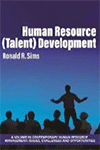
Human Resource (Talent) Development
By:
Ronald R. Sims, William & Mary
A volume in the series: Contemporary Human Resource Management Issues Challenges and Opportunities. Editor(s): Ronald R. Sims, William & Mary.
Published 2023
The rapidly transforming environment that we live in has made human resource development (HRD) all the more necessary for the success of today’s organizations. HRD initiatives help their organizations by developing employees who assist their organizations in not only surviving, but thriving in our increasingly global world. Today’s best practice or benchmarked organizations and their HRD professionals continue to recognize the importance of employee learning, knowledge, skills and motivation to organizational success. This recognition increasingly opens many doors as organizational leaders accept the fact that HRD initiatives can be used to ensure that organization members have what it takes to successfully meet the demands that confront them and their organizations.
This book takes the position that HRD can demonstrate how their initiatives help to develop a superior workforce so that the organization and its individual employees can accomplish their strategic and operational goals in service to their clients or customers. This book is written with the belief that HRD professionals have many opportunities to learn, change and find ways both in and outside of the workplace to contribute to the development of learning organizations as we move further into the 21st century. A major point of this book is that HRD will continue to become more and more important to organizational success when one considers the increased responsibilities HRD professionals have taken on during and post- the COVID pandemic.
The primary audience for this book is practicing HRM and HRD professionals, and other organizational leaders. The book provides proven ideas important to demonstrating the value of HRD. From a practical viewpoint, it is based on actual experience, a strong research base, and accepted practices presented in an easy to read form. A second target audience is students of HRD and HRM who are preparing for careers in this important field. This book will help them develop a solid foundation to the study of HRD practices or initiatives that are key to HRD success regardless of the type of organization. A third target audience is managers or leaders at all levels of an organization who are expected to take on a number of HRD responsibilities (e.g., as trainers, coaches, mentors, change agents, and so on) while regularly partnering with HRD professionals. It offers these individuals a firsthand look at what they should expect of their HRD functions or areas and how they can effectively work with HRD professionals in their organizations to achieve the organizations strategic goals by getting the most out of its human people.
CONTENTS
Preface. CHAPTER 1: Human Resource Development: An Introduction. CHAPTER 2: Toward an Understanding of What Motivates Today’s Employees. CHAPTER 3: Maximizing Learning in Human Resource Development: The Role of Learning and Learning Styles. CHAPTER 4: Assessing Human Resource Development Needs. CHAPTER 5: Designing Effective Human Resource Development Initiatives. CHAPTER 6: Employee Learning, Training, and Development Methods and Initiatives. CHAPTER 7: Developing an Effective Learning Climate in Human Resource Development Initiatives. CHAPTER 8: Evaluating Human Resource Development Initiatives. CHAPTER 9: Employee Socialization and Orientation/Onboarding. CHAPTER 10: Human Resource Development: Focusing on Management or Leadership Development. CHAPTER 11: Human Resource Development, Organizational Change and Development. CHAPTER 12: Human Resource Development: Bridging Today and Tomorrow. About the Author.
-
Paperback979-8-88730-166-2
Web price: $62.04 (Reg. 72.99)
-
Hardcover979-8-88730-167-9
Web price: $89.24 (Reg. 104.99)
- eBook979-8-88730-168-6

- BUS030000 - BUSINESS & ECONOMICS: Human Resources & Personnel Management
- BUS066000 - BUSINESS & ECONOMICS: Training
- BUS041000 - BUSINESS & ECONOMICS: Management
-
 A Contemporary Look at Business Ethics
A Contemporary Look at Business Ethics
-
 Human Resources Management and Ethics
Responsibilities, Actions, Issues, and Experiences
Human Resources Management and Ethics
Responsibilities, Actions, Issues, and Experiences
-
 Human Resources Management Issues, Challenges and Trends
"Now and Around the Corner"
Human Resources Management Issues, Challenges and Trends
"Now and Around the Corner"
-
 Leadership, Leaders and Leading
Leadership, Leaders and Leading
-
 Succeeding as a Frontline Manager in Today’s Organizations
Succeeding as a Frontline Manager in Today’s Organizations
-
 The Ethically Responsible Organization
The Ethically Responsible Organization
-
 When a New Leader Takes Over
Toward Ethical Turnarounds
When a New Leader Takes Over
Toward Ethical Turnarounds

